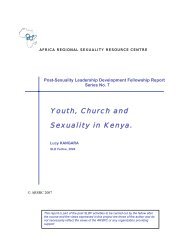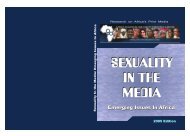body images beauty culture and language - Africa Regional ...
body images beauty culture and language - Africa Regional ...
body images beauty culture and language - Africa Regional ...
You also want an ePaper? Increase the reach of your titles
YUMPU automatically turns print PDFs into web optimized ePapers that Google loves.
traditional cultural codes in relation to <strong>body</strong> parts, complexion, overall physiology <strong>and</strong><br />
aesthetic appearance, though as we shall clarify below, often subject to a corresponding<br />
moral evaluation. This inscription of <strong>body</strong> <strong>and</strong> <strong>beauty</strong> in <strong>language</strong> manifests in names,<br />
cognomens, terms, tags, sayings, aphorisms, riddles <strong>and</strong> extended aesthetic forms such as<br />
poetry, folklore, nuptial songs; in sundry oral expressions <strong>and</strong> cultural practices.<br />
Amongst the Yoruba, largely located in South-western Nigeria but with socio-political<br />
<strong>and</strong> cultural satellites in many other parts of the country, in West <strong>Africa</strong> <strong>and</strong> in the<br />
<strong>Africa</strong>n diaspora, <strong>body</strong> parts such as ẹyinjú (eyeball(s)), eyín (tooth/teeth), ọmú<br />
(breast(s)) <strong>and</strong> ìdí (buttock(s)) occur frequently as central focus in traditional sayings<br />
about <strong>beauty</strong>. Specific aesthetic values are correlated to the various parts by means of<br />
adjectival modification, for example from ẹyinjú (eyeball(s)), we have ẹl-éyinjú-ẹgé<br />
(“one with delicate/graceful eyeballs”). The <strong>body</strong> parts are adorned, quite literally, in<br />
<strong>language</strong>, through similes <strong>and</strong> condensed similes (metaphors) within the names or<br />
sayings. Complexion <strong>and</strong> overall appearance are also rhetoricised in the <strong>language</strong> through<br />
sundry names <strong>and</strong> expressions. The list below is representative but not exhaustive. The<br />
items are fairly self-explanatory, while notes are provided where deemed necessary.<br />
EXAMPLES OF INSCRIPTION OF BODY AND BODY AESTHETICS IN<br />
YORUBA LANGUAGE FORMS<br />
adúmáadán (dark shiny-smooth)<br />
apọÏnbéporé (“smooth, palm-oil red”). 5<br />
ẹlẹÏyinjú ẹgẹÏ (“one with graceful eyeballs”)<br />
Eyinfunjowo (“teeth whiter than money” – cowrie shells being previous<br />
medium of exchange)<br />
Funfun niyì eyín (“whiteness is the <strong>beauty</strong> of teeth”)<br />
Gígúnrégé niyì orun (“straightness is the <strong>beauty</strong> of the neck”)<br />
5 Basically this means ‘fair’ or “light complexioned”. The item, “red” (pupa or its adverbial derivative pón)<br />
in Yoruba covers a broad spectrum of colours that range from “red” to “brown” <strong>and</strong> even “yellow.”<br />
Colours within the spectrum are sometimes distinguished by post-modification, e.g. ó pón ràkọÃr‡kọÃ<br />
(brown) ó pupa fòò (bright red), etc. Other indigenous Nigerian communities also often refer to complexion<br />
by means of reference to the colour of things, e.g. “colour of anthill,” an expression popularized by Elechi<br />
Amadi’s The Concubine (1966).






